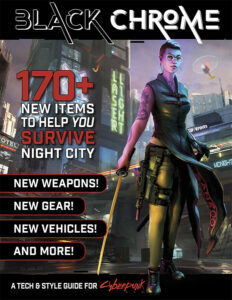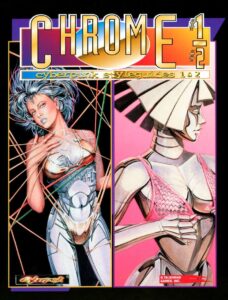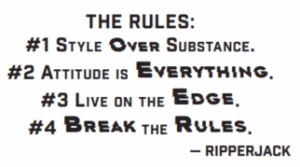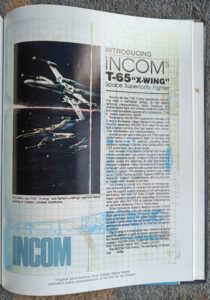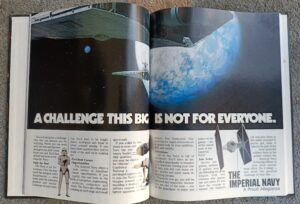BLACK CHROME IS A 2023 gearbook for the Cyberpunk Red roleplaying game, written by James Hutt, Jay Parker, Turbo, J Gray, Anne Morrison, Chris Spivey, Fran Stewart, and Linda M Evans, and published by R Talsorian Games.
- Read the Wikipedia entry for the Cyberpunk RPG
- Read about Black Chrome on DriveThruRPG
- See the Cyberpunk Red rulebook on DriveThruRPG
“Did they just describe Grindr for laser-katanas?” – Greg
This episode is brought to you with the help of our Kickstarter backers, and in particular Chris, who just wanted to be acknowledged as ‘Chris’, who wanted a shoutout to the friends to whom he has recommended this podcast, and also to James for sinking his effing barge. Thanks to Chris and to everyone else whose donations make Ludonarrative Dissidents possible.
Digital copies of Black Chrome and Cyberpunk Red were provided by R Talsorian Games for the purposes of this episode. Our thanks go to them.
>>>>>THE AUDIO FOR THIS EPISODE IS CURRENTLY ONLY AVAILABLE TO THE PODCAST’S BACKERS. WHEN IT GOES PUBLIC, THE LINK TO THE RECORDING WILL APPEAR ON THIS PAGE. TO GET EARLY ACCESS, YOU CAN BECOME A SEASON 3 BACKER FOR JUST $20 BY CLICKING HERE
SHOW NOTES
These are the notes for the episode, a chance for us to pick up the threads, fill in the blanks and correct the occasional errors that we didn’t have time to pursue in the episode itself.
‘Gear books’ or ‘gear guides’ like Black Chrome are RPG books describing extra equipment for PCs and NPCs and how to get it. They’re a long-standing part of RPG culture, dating back to the early 1980s. People disagree on the first, but the Palladium Guide to Weapons & Armour (1981) has a fair claim to the title and is still in print, albeit in a very revised version.
Chris Spivey, co-author on Black Chrome, is best known as the creator of Harlem Unbound, a 2017 Call of Cthulhu and pulp sourcebook to the eponymous New York district, set during the Jazz Age of the 1920s. It was acclaimed by critics and shortlisted for the Diana Jones Award in 2018.
We talked about this last time, but the Cyberpunk Red TTRPG exists because of the Cyberpunk 2077 CRPG, the high-budget AAA videogame released by CD Projekt Red in 2020. Cyberpunk Red is a prequel, set in the year 2045, the ‘time of the Red’, but undeniably influenced by material developed for its sibling.
Greg’s dislike of the future conditional tense is well known, but I have to wonder if there should be a little leniency if we’re discussing an SF game, since it’s set in the future. A subject for another episode.
The original four Chromebooks for the first-edition Cyberpunk RPG were released between 1991 and 1995, and set a benchmark for the graphic presentation of black-and-white RPG products, with cutting edge layout and crisp artwork that perfectly captured the style of its subject. They are still available, though these days they’re actually the digital documents that they pretended to be in the 1990s. Their approach of presenting the books as in-world documents was much imitated, notably by supplements for SLA Industries.
We apologise for our technical difficulties in navigating the Black Chrome PDF and what happens when you click on the various page-elements. We’ve now tried it in a number of PDF readers and browsers: it seems fine in most of them but has some problems with a couple of lesser-used Chromium-based browsers including Vivaldi, particularly if they’re demanding updates, and is mostly fine but not perfect in Firefox.
Power creep, which Ross discusses, is essentially inflation in games. In RPGs it’s the inevitable increase of the base power-level, as supplements introduce new types of weapons, equipment and PC abilities that are better or at least more refined than the ones in the core rulebook. Even if new gear is power-matched to the existing material, enterprising players can often find ways to gain better effects from their loadout by clever mixing and matching. Power creep can be avoided but takes a huge amount of discipline on the part of the design team, and it’s often easier to reboot the setting every few years instead.
Splatbooks, as James described, are books that go into deeper detail on facets of player-characters’ backgrounds, allowing greater customisability, richer character-building, and kewler powers. Often this contributes to power-creep. They came to the fore in the 1990s, but have been around as long since the late 1970s, including notable early titles such as Mercenary for Traveller and Cults of Prax for Runequest.
‘Frustrated novelists’ – Greg is being self-mocking here, since two of the Ludonarrative Dissidents team have written official game novels, but it’s worth noting that White Wolf’s RPG lines spawned novelists such as Rich Dansky and Chuck Wendig, while a number of other well-known authors got their start in RPG design including Mike Stackpole, Aaron Allston, Charles Stross, Jo Walton, and Genevieve Cogman.
Night markets are markets that operate at night, usually more relaxed than day-markets with more leisure-based activities. They originated in Tang-dynasty China over a thousand years ago and play a big part in many south-east Asian cultures. Taiwan alone has over seven hundred. A few exist in North America and Europe but they’re culturally different. What Europe does have, and which may be closer to Cyberpunk‘s night markets, is the folklore of goblin markets, summed up in Christina Rossetti’s 1862 poem ‘Goblin Market‘, which also operate at night and where rare and exotic things may be bought. The UK also has a tradition of certain markets operating under the medieval concept of ‘Marché ouvert’ or ‘Market Overt’, meaning that it was legal to sell goods without proper title (in other words stolen goods) between sunrise and sunset. ‘Market Overt’ was only abolished in 1995.
‘Time is a flat circle’ (Greg) is a reference to the ‘eternal return’ doctrine espoused by Nietzsche and P D Ouspensky, co-opted by Matthew McConaughey’s character Rust Cohle in the first season of True Detective (2014). A lot of the philosophy and underlying themes of that season are borrowed without attribution from horror author Thomas Ligotti, particularly his non-fiction book The Conspiracy Against The Human Race, to the great frustration of many people.
‘The rules’ stated early in the Cyberpunk Red rulebook, and which have been in the game since the first edition in 1988, are as follows:
James says that chrome is decorative, it’s not useful, which is partly true. Chrome is not just a browser from Google, it is a silvery-grey transition metal with the atomic number 24, used primarily in the creation of stainless steel and for decoration: it can be highly polished (reflecting 70% of visible and 90% of infrared light) and resists tarnishing through the trick of passivation: exposed to air, its surface forms a layer of chromium oxide a few atoms thick which protects the rest of it without losing the pretty shine, and that’s how stainless steel works. Aluminium does the same thing but in a less pretty way.
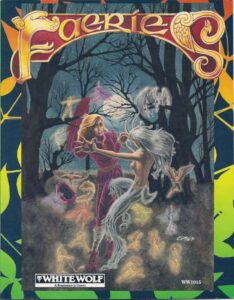 Several RPG supplements have been banned for explicit sexual content, where ‘explicit’ is whatever an oversensitive viewer has considered unacceptable. In the 1980s and 1990s the distribution and retail layer of the games market was very jumpy about this sort of thing, the aftershocks of the satanic panic still reverberating around the culture, and would refuse to stock any game that transgressed. The book James was specifically thinking of was the Faeries supplement for Ars Magica (1991), the cover of which has a barely visible nipple (see right), but if you want to know more then Shannon Appelcline wrote an excellent article on the subject of banned RPG books a few years ago. Digital publishing has torn down the barriers and now (heaven knows) anything goes.
Several RPG supplements have been banned for explicit sexual content, where ‘explicit’ is whatever an oversensitive viewer has considered unacceptable. In the 1980s and 1990s the distribution and retail layer of the games market was very jumpy about this sort of thing, the aftershocks of the satanic panic still reverberating around the culture, and would refuse to stock any game that transgressed. The book James was specifically thinking of was the Faeries supplement for Ars Magica (1991), the cover of which has a barely visible nipple (see right), but if you want to know more then Shannon Appelcline wrote an excellent article on the subject of banned RPG books a few years ago. Digital publishing has torn down the barriers and now (heaven knows) anything goes.
Doctor Adder is a 1984 pre-cyberpunk novel by K W Jeter. It was written in 1972, at the start of his career, but it was hard to sell because of the level of sex and violence, extreme for the time. Dr Adder is the titular plastic surgeon who specialises in genitals. There’s some good stuff in there, I remember. Philip K Dick liked it, possibly because his work was a major inspiration for it.
Tetsuo: the Iron Man (1989) (trailer) is the other notable 1980s fictional source for self-augmented genitals, a micro-budget Japanese movie about people who become part-metal, some voluntarily and others not so much. It became a surprise hit and was followed by Tetsuo 2: Body Hammer (1992) which has a bigger budget, better effects and a story you can almost follow, but lacks the viscerality ad sheer bonkersness of the original.
In the late 80s and early 90s, as the early internet made it clear that cyberpunk wasn’t all fiction, there was a lot of excitement about teledildonics, or tech/internet-enhanced sex toys, from remote-controlled vibrators up to VR and full immersion suits. Some of that has come to pass and has mostly turned out to be less exciting than hoped. Partly this was due to the actions of an over-zealous owner of an early patent who squashed a lot of potentially juicy research and product development.
 Modern Primitives was a 1989 book in the RE/Search Publications series, documenting extreme tattooing, piercing and body modification practices, including interviews with practitioners and subjects. It was ground-breaking and shocking in its day, and the subject of an obscenity trial in the UK in 1991, but many of the things it showed are now mainstream, and it’s not unusual to see a few of them on display in a typical episode of Channel 4’s Naked Attraction dating show in the UK.
Modern Primitives was a 1989 book in the RE/Search Publications series, documenting extreme tattooing, piercing and body modification practices, including interviews with practitioners and subjects. It was ground-breaking and shocking in its day, and the subject of an obscenity trial in the UK in 1991, but many of the things it showed are now mainstream, and it’s not unusual to see a few of them on display in a typical episode of Channel 4’s Naked Attraction dating show in the UK.
The late 80s and 90s also saw a blooming of magazines excited about the coming future and its tech, including Mondo 2000, the original print version of bOING bOING, and the UK’s short-lived Black Ice. Generally there was a fair overlap with smart drugs, expanded consciousnesses, life extension, conspiracy theories, and fetish. Great source material for retro-future cyberpunk campaigns.
‘Shopping sessions’…. Activity during RPGs falls into three main phases: exploration, combat, and downtime, where the last of those is the paperwork space between adventures where characters calculate experience, do training and get new equipment. In narrative terms these are usually done as a montage or in long-shot. However it can be fun to run them as a regular RPG session as the PCs walk through the streets shopping, talking, running into old friends and possibly encountering NPCs and stuff that may be relevant in the future. Let them relax as their characters and have a bit of fun without looking for glory, XP or narrative advancement, and your campaign will be all the richer for it.
The Familiar was an RPG magazine that ran for nine issues in the mid-1990s. The comic strip that Greg refers to could have been ‘Chronicles of Illaddin’ by Charles Wolf but beyond that our detective skills are coming up dry. Do you know more?
The story of PlayPumps, the waterpumps for African villages designed to be powered by children playing, is sadly not apocryphal. A well-intentioned and expensive disaster.
Pixelbitching is ‘the act of sweeping your mouse cursor across any given screen of such a game, in order to find the minute cluster of pixels you need to progress.’ Modern game designers mostly know better these days.
Talking about disruptions to the global supply chain – this episode was recorded before the introduction of Trump’s tariffs, which will probably destroy the tabletop games industry in its current form.
There are two types of ‘sandbox games’. The first are videogames with space for undirected player creativity or play that’s not goal-oriented, like Minecraft. The other type comes from wargaming, where for centuries a sandbox was literally a box of sand in which players would sculpt terrain for miniature forces to battle over. The first meaning has almost completely subsumed the original.
The gyrocopter that featured in You Only Live Twice (1967) was Little Nellie, technically the Wallis WA-116 Agile, created and flown by its creator Wing Commander Ken Wallis (no relation). In the movie it fits into four suitcases; in real life not so much. Gyrocopters use an unpowered rotor for lift, meaning they require a short runway and cannot hover, but are otherwise fantastic little aircraft.
The Flipper Zero is a ‘multi-tool device for geeks’ and a meatspace hacker’s wet dream in a small plastic case that looks like a toy. For £189 you can hack infrared, radio signals, RFID, NFC, Bluetooth, cars and much more. If ordering one, we recommend you use an anonymous prepaid card and a dead-drop delivery address.
GunMart, purveyor of unreliable but affordable guns, is a new addition to the Cyberpunk universe with Cyberpunk Red. It’s the sort of background detail that brings a shopping session alive: can your character afford that boutique hand-made +1 longsword with the custom grip, or will you have to get an off-the-peg one at Bert’s Apprenticery, with a blade that looks suspiciously like it used to be a plowshare?
Digital Gladiator: there’s a full description of this on the Cyberpunk Fandom wiki, which also contains descriptions of much, much stuff from the Cyberpunk universe.
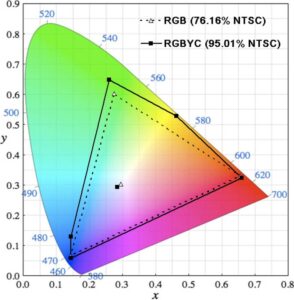 It is possible that James really can’t tell pink and purple apart, this is not the first time this has happened and he also sees shades of deep blue as black. But it may also be down to the colour calibration of the monitor or something else. Standard RGB monitors cannot accurately show the colour violet, for example, because violet as defined by Sir Isaac Newton is light with a wavelength between 380 and 450 nanometres, not a combination of other colours like the RGB gamut. If that’s not clear, have a look at this diagram: anything within the dotted line is within the scope of RGB, anything outside isn’t, and if it all looks kind of the same to you, that’s because you’re looking at it on an RGB screen. You literally see the problem. CMYK, used for print, is better but still not perfect.
It is possible that James really can’t tell pink and purple apart, this is not the first time this has happened and he also sees shades of deep blue as black. But it may also be down to the colour calibration of the monitor or something else. Standard RGB monitors cannot accurately show the colour violet, for example, because violet as defined by Sir Isaac Newton is light with a wavelength between 380 and 450 nanometres, not a combination of other colours like the RGB gamut. If that’s not clear, have a look at this diagram: anything within the dotted line is within the scope of RGB, anything outside isn’t, and if it all looks kind of the same to you, that’s because you’re looking at it on an RGB screen. You literally see the problem. CMYK, used for print, is better but still not perfect.
Black Chrome Plus, the free add-on to the Black Chrome supplement and including the night-market maps and a bunch more other free stuff for the game, can be downloaded by clicking its name at the start of this sentence. Or here.
The ‘Kibble’ low-end foodstuff in the Cyberpunk universe has many precedents in dystopian SF, most memorably ‘soylent green’ from the film of the same name. Soylent Green was based on Harry Harrison’s novel Make Room! Make Room! in which ‘soylent’ is simply a cheap blend of soya and lentils that has largely replaced meat. Not, you know, the other thing.
The media character-type in the Cyberpunk RPGs is clearly inspired by the 1985 telefilm Max Headroom: 20 Minutes into the Future and the subsequent TV series, in which Matt Frewer played roving investigative reporter Edison Carter and his digital counterpart Max. Made and first shown in the UK, the original film was partly recast and reshot for its American debut (becoming the ‘Blipverts’ pilot), with a somewhat lighter tone. Here’s the whole original UK version – UK RPG stalwart Mike Cule has a brief part as a man who explodes from watching blipverts. As usual with these things, the element that really dates it is all the CRT TV screens.
Max Headroom got so much attention that its creators, Rocky Morton and Annabel Jankel, were offered a Hollywood deal, which led a few years later to the Super Mario Bros movie. Don’t hold that against it.
We overviewed the strikingly different gearbook Double Tap for Night’s Black Agents in LND season 3 episode 4, and had opinions about it.
James mentions numerical ratings on reviews and the tyranny of ‘7/10’. This is the same phenomenon as power creep and grade inflation: since the 90s a 7/10 rating has been seen as ‘average’ in video games reviewing, and today’s online algorithms treat anything less than 5/5 (e.g. on Amazon or Uber) as below average. On one level you could say that since there’s so much material out there, so much new every month, that consumers demanding a minimum of 70% quality is merely sorting the sheep from the chaff. On the other hand, we’ve grown so inured to inflation in so many parts of our lives that we should resist it in our arts with every ounce of strength we have. Anyway, if you like something then you should leave it a rating or a review online, because it really does make a difference to its visibility, and please give it full marks or you could actively be damaging it.
Fake adverts in RPG books is something we’ve mentioned before but these images are from where it started and have never been equalled: the colour pages from the Star Wars Roleplaying Game by Greg Costikyan (West End Games, 1987). We recommend you blow them up big to read the text. Enjoy.
Thank you for listening! The hosts of this episode were Ross Payton, Greg Stolze and James Wallis, with audio editing by Ross and show notes by James. We hope you enjoyed it. If anything in this episode or these notes has spurred your interest then we invite you to come and chat about it on our friendly Discord.
If you click on any of the above links to DriveThruRPG and buy something, Ludonarrative Dissidents will receive a small affiliate fee. You will not be charged more, and the game’s publisher will not receive less, it’s a win-win-win. Thank you for supporting the podcast this way.
